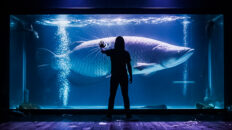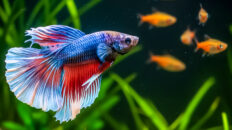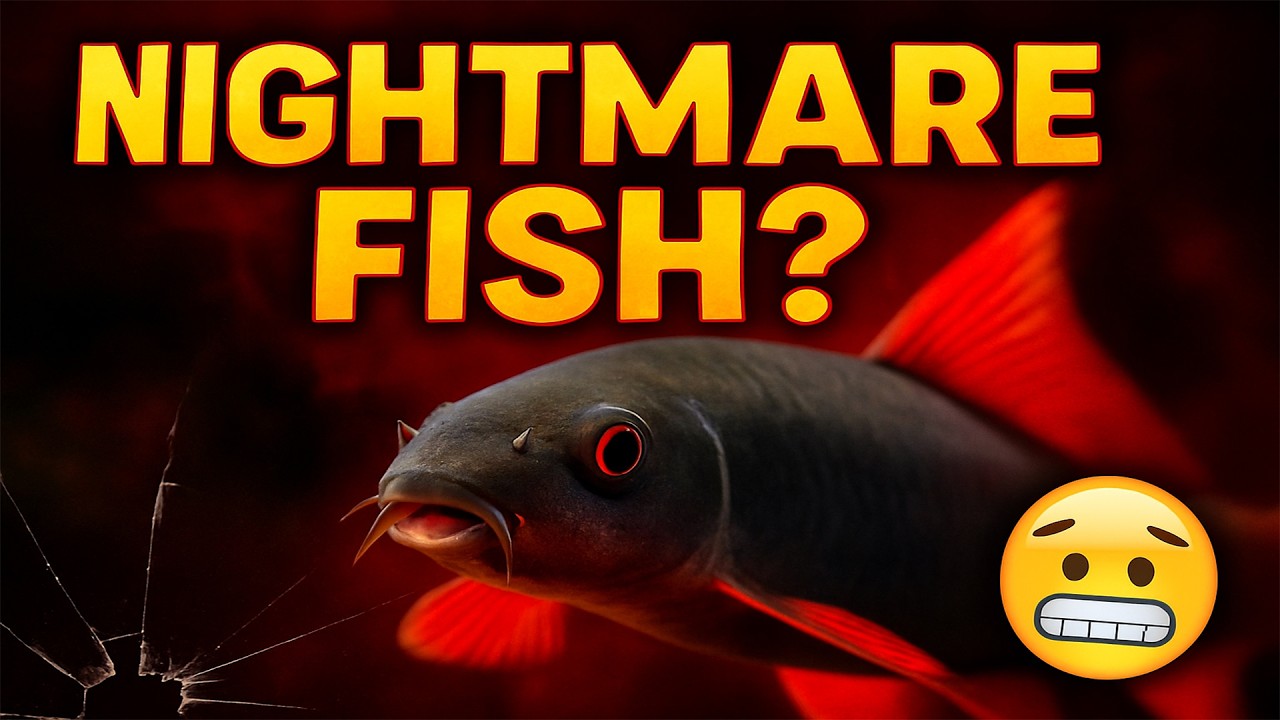Ever seen your “peaceful” aquarium turn into a war zone overnight? One wrong fish choice can turn harmony into chaos. Many hobbyists learn this lesson the hard way—by adding so-called peaceful fish that turn into bullies or predators once they grow. In this guide, we’ll count down the Top 10 most aggressive aquarium fish you should never keep in a tank unless you’re ready for a full-blown aquatic battlefield.
Why Aggressive Fish Cause Chaos in Community Tanks
Every fish has instincts—territorial, predatory, or competitive. When you mix incompatible species, those instincts take over. The result? Torn fins, dead tankmates, and constant stress. Aggressive aquarium fish aren’t evil—they’re just being themselves. The real mistake is putting them in the wrong environment.
The “Monster Fish” Problem
Some species, like Oscars or Red Devil Cichlids, are incredible to watch but require enormous tanks, powerful filtration, and solitary setups. When kept in small aquariums or with community fish, they become uncontrollable forces of destruction. This list will help you avoid those heartbreaks.
#10 Tiger Barb – The Fin-Nipping Bully
Small but deadly. Tiger Barbs look innocent, but their habit of nipping fins makes them a nightmare for slow-moving or long-finned fish like bettas, guppies, and angelfish. They should only be kept in large, active schools (10+) to disperse aggression—but never in peaceful tanks.
#9 Red Tail Shark – The False Peacekeeper
Red Tail Sharks are beautiful with their sleek black bodies and vibrant red tails, but don’t be fooled—they’re highly territorial. In smaller tanks, they claim the entire bottom area as their domain, attacking anything that enters their space. Perfect for solo setups, but not community aquariums.
#8 Convict Cichlid – Tiny but Tank Terror
Don’t underestimate size. Convict Cichlids are small, yet incredibly aggressive, especially during breeding. They will chase and bite any fish that comes near their eggs. Even larger fish like Oscars avoid them. Keep them in species-only tanks unless you want a war zone.
#7 Jack Dempsey – The Heavyweight Fighter
Named after the famous boxer, Jack Dempseys live up to their name. They are powerful, territorial, and destructive. Males will often attack anything in sight during spawning. These fish need a large tank (75+ gallons) and equally robust tankmates—or better yet, a tank of their own.
#6 Mbuna Cichlids – Colorful Chaos
Don’t let their stunning colors fool you. Mbuna Cichlids from Lake Malawi are some of the most territorial fish in the world. They constantly fight for rock caves and dominance. If you want to keep them, use a heavily structured rockscape and overstock slightly to spread out aggression—but never mix them with peaceful tropical fish.
#5 Oscar – The Aquarium Bulldozer
Oscars are intelligent and full of personality, but they’re also destructive. They uproot plants, knock over decorations, and attack smaller fish. These carnivores grow fast and need tanks over 75 gallons. Oscars are best kept either solo or with other large, equally tough fish.
#4 Bucktooth Tetra – The Scale-Eating Predator
This fish looks like a peaceful schooling species until you realize it’s the piranha’s cousin. Bucktooth Tetras are known to bite scales off tankmates and hunt in groups. In the wild, they prey on larger fish, stripping them alive. Only experienced aquarists with species tanks should attempt keeping them.
#3 Red Devil Cichlid – The Equipment Destroyer
The Red Devil lives up to its name. They destroy everything—plants, decor, even heaters and filters. Known for their strong jaws and territorial nature, they will kill anything entering their space. These fish can grow up to 15 inches and need massive tanks and solitary setups.
#2 Wolf Fish – Predator That Eats Tankmates Whole
True to its name, the Wolf Fish is a savage predator capable of swallowing other fish whole. It’s not a community fish—it’s a tank boss that requires its own heavily secured tank. Even species of the same kind often end up fighting to the death.
#1 Goliath Tigerfish & Snakehead – The True Monsters
These are apex predators in the fishkeeping world. Goliath Tigerfish have razor-sharp teeth and unmatched aggression, while Snakeheads are banned in many regions for their invasive behavior and ability to survive outside water. Both are fascinating but never suitable for home aquariums. Leave these giants to professional aquarists or public aquariums.
Bonus Myth: Aggression Isn’t Just About Species
Many hobbyists assume aggression is purely species-based, but tank size, decor, and stocking density also matter. Even peaceful fish can become aggressive in cramped or unbalanced environments. Creating territories with rocks, plants, and caves reduces stress and helps maintain order.
Scientific Insight: Why Fish Become Aggressive
Aggression in fish is often linked to competition for food, mates, and territory. Studies in fish behavior reveal that confined environments increase cortisol levels (stress hormones), leading to heightened territorial aggression (Oxford Academic – Behavioral Ecology).
Research on cichlid species has shown that dominance hierarchies and environmental design directly affect aggression levels. Tanks with more visual barriers (plants and rocks) significantly reduce conflict (ScienceDirect – Applied Animal Behaviour Science).
Another study found that fish aggression correlates with water quality and crowding, as ammonia spikes increase stress-induced hostility (Springer – Fish Physiology & Biochemistry). In short: poor water, tight spaces, and bad pairings trigger natural instincts—sometimes fatally.
How to Prevent Fish Aggression
- Choose tankmates carefully. Avoid mixing species with different temperaments or size differences.
- Provide hiding spots. Caves, driftwood, and plants help fish establish boundaries.
- Don’t overstock. Crowded tanks increase stress and aggression.
- Feed properly. Hungry fish are more aggressive—maintain consistent feeding schedules.
- Use tank dividers. In severe cases, separate aggressive individuals temporarily.
Watch the Full Video
For visuals, examples, and real-life experiences, watch the full countdown here:
Top 10 Aggressive Monster Fish You Should NEVER Keep in a Tank.
Timestamps
- Why Monster Fish Don’t Belong in Community Tanks
- #10 Tiger Barb – The Fin-Nipping Bully
- #9 Red Tail Shark – The Tank Boss
- #8 Convict Cichlid – Tiny but Tank Terror
- #7 Jack Dempsey – The Fighter
- #6 Mbuna Cichlids – Colorful Chaos
- #5 Oscar – The Bulldozer
- #4 Bucktooth Tetra – The Scale Eater
- #3 Red Devil – The Destroyer
- #2 Wolf Fish – Predator
- #1 Goliath Tigerfish / Snakehead – The True Monsters
- Bonus Myth: It’s Not Just About Species
Final Thoughts
Keeping aggressive fish can be thrilling, but it requires responsibility and respect for their natural instincts. If you’re a beginner, focus on compatible species and build your way up to larger, more demanding fish. Remember—every “monster” fish deserves proper space, setup, and care.
About FishTank Mastery
FishTank Mastery provides honest, experience-based advice for hobbyists across the US, UK, and Europe. Our goal is to help aquarists avoid costly mistakes, understand natural fish behavior, and create stable, thriving aquariums. Subscribe to our YouTube channel for weekly guides, myth-busting videos, and pro-level aquarium insights.

Related Reads: Avoid Tank Chaos and Choose the Right Fish
If you’ve just learned about the most aggressive aquarium fish to avoid, you’ll also want to understand that some “peaceful” fish can be just as problematic. Our article on 7 peaceful fish you’ll regret buying explains how common community species can secretly stress or even harm their tankmates. It’s a must-read before you buy your next “friendly” fish.
Before stocking any aquarium—especially one with territorial species—make sure your tank is fully ready. The guide Wait Before Adding Fish: 5 Signs Your Tank Is Ready helps you confirm your water parameters, filtration, and nitrogen cycle are stable enough to support your new residents safely.
Some fish look adorable but turn into underwater assassins as they mature. Don’t miss Top 7 Aquarium Fish That Look Cute But Are Secret Killers—a guide to identifying those “wolf in sheep’s clothing” species that can devastate peaceful tanks overnight.
If you’re planning your first community tank, learning which species to avoid is key. Check out 7 Worst Aquarium Fish That Ruin Tanks Fast and 5 Peaceful Fish That Secretly Cause Big Problems to understand how even harmless-looking fish can upset tank balance, outcompete others, or introduce hidden aggression.
And if you’re determined to build a balanced aquarium, choose your tankmates wisely. Discover some of the most peaceful and colorful community species in our detailed guide: Top 7 Schooling Fish for Freshwater Aquariums. These active yet gentle fish can help restore harmony after you’ve avoided the “monster” and “fake peaceful” species.
Discover More from FishTank Mastery
Want more proven aquarium advice? Visit FishTankMastery.com for expert fishkeeping guides, myth-busting articles, and beginner-friendly aquarium tips. Don’t forget to subscribe to our YouTube channel for weekly videos on aquarium setup, maintenance, and species care—helping you create the thriving tank you’ve always wanted.










Add comment